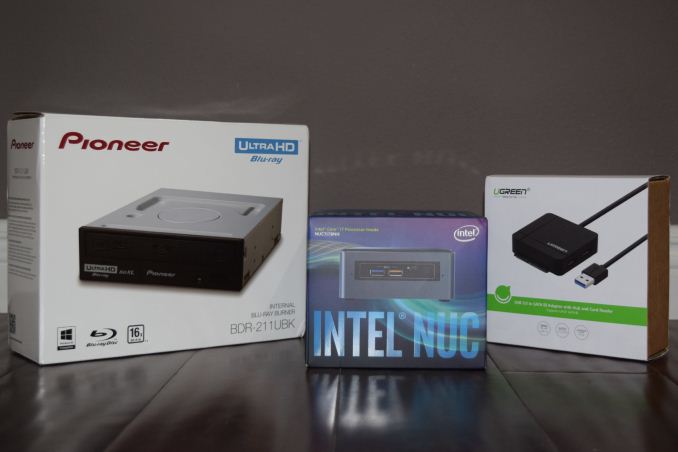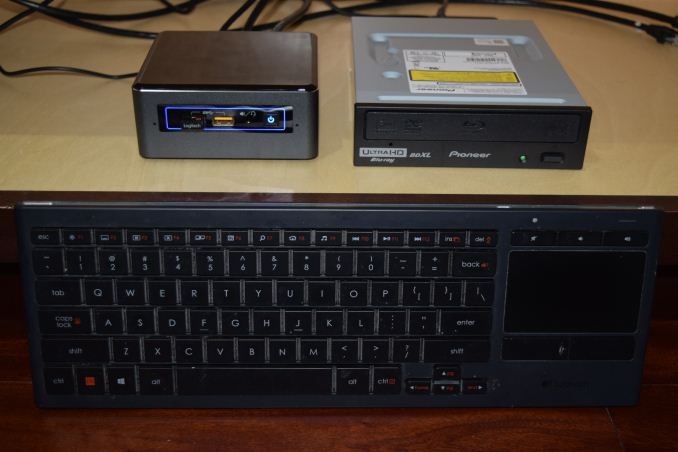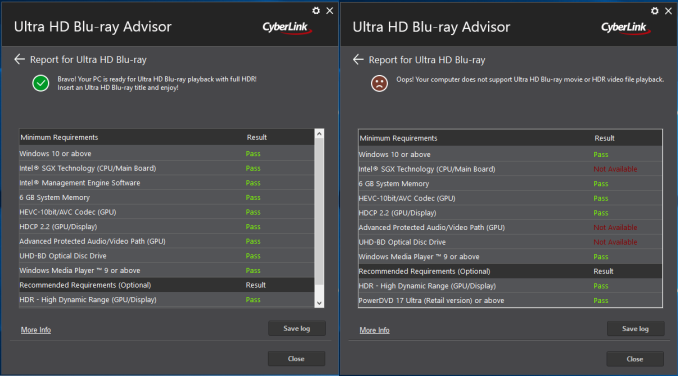A Budget Home Theater & PC Setup: 4K, HDR, UHD Blu-ray, and More
by Ganesh T S on December 26, 2017 8:30 AM ESTConfiguring a UHD Blu-ray Playback System
The rise in popularity of OTT streaming has coincided with a decline in the popularity of physical media formats such as Blu-rays. Irrespective of the market statistics, it is indisputable that the bitrates possible with the latter simply can't translated to OTT services. Bitrates usually directly correlate with video quality, though, beyond a certain point, it becomes very difficult to distinguish. HD audio formats such as Dolby Atmos, DTS-HD MA, Dolby TrueHD etc. are also yet to be widely adopted by OTT streaming services. On top of all these, Blu-rays are often treated as collectibles by some consumers.
UltraHD (UHD) Blu-rays (with their 4K resolution videos encoded in HEVC) were a bit slow to take off. On the PC front, the number of licensed software Blu-ray player vendors has come down from 3 (ArcSoft, Corel, and CyberLink) to just CyberLink alone. PowerDVD 17, with UHD Blu-ray support, was released in April 2017. The hardware requirements were quite specific, and we decided to pass up on a hands-on review at that time.
While reviewing the Intel NUC7i7BNH, I realized that it came with support for SGX, one of the primary requirements for PowerDVD 17 to play back UHD Blu-rays. I also remembered that the BIOS of the ASRock Beebox-S 7200U had a SGX option. Both of these systems also had a LSPCon on board to support HDMI 2.0 with HDCP 2.2 capability. Pioneer launched the BDR-211UBK in March, but, had specifically indicated that KBL-U was incompatible. However, based on our discussions with both CyberLink and Intel, we decided to give the drive a try by connecting the internal SATA ODD using a compact SATA-USB bridge.
The Pioneer BDR-211UBK and the UGREEN SATA-USB Adapter Combine to Make the Intel NUC7i7BNH a UHD Blu-ray Player
We looked up Amazon for a compact bridge and chanced upon a versatile UGREEN adapter. In addition to supporting the SATA drive, it also had a couple of USB 3.0 Type-A extension ports and a microSD reader. This made sure that the optical drive would not completely take over the USB port in the host system.
Using an Internal Drive without an Enclosure is not an Issue if the Setup is Tucked Out-of-Sight
After setting up the hardware and configuring the BIOS appropriately in the two systems, we installed the Management Engine components. The next step was to confirm that the system and allied components were correctly set up for UHD Blu-ray playback with HDR. CyerbLink provides the Ultra HD Blu-ray Advisor tool for this purpose. It also helpfully points out missing ME components or mis-configured BIOS options. Even though we were aware that the Zotac ZBOX MAGNUS EN1080K doesn't pass the requirements check (no SGX, iGPU inactive), we did try out the tool on it also.
The CyberLink Ultra HD Blu-ray Advisor (L: ASRock Beebox-S 7200U, R: Zotac ZBOX MAGNUS EN1080K)
Even though it is possible that the Zotac EN1080K might enable SGX in a future BIOS release, the use of the Intel GPU is probably disabled at the board level. This means that there is no protected audio/video path for secure decoding of the UHD Blu-ray streams. Given that there is no talk of UHD Blu-ray support from NVIDIA Pascal, consumers shouldn't keep their hopes up regarding the possibility of UHD Blu-rays getting played back on NVIDIA Pascal-equipped systems. Coming back to the results of the UHD BD Advisor tool, we find that the two KBL-U systems pass all the checks. We purchased a retail copy of the Planet Earth II UHD Blu-ray for testing out our setup.













191 Comments
View All Comments
Bullwinkle-J-Moose - Thursday, December 28, 2017 - link
Quote from edzieba....."That's... not how things work. At all. Adding an S/PDIF cable is not going to magically allow transport of audio streams that:
a) Are too high bitrate for S/PDIF (which cannot even carry 5.1 LPCM)
b) Were developed decades after the S/PDIF standard "
----------------------------------------------------------------------------------------------
You seem to be forgetting that "I make the standards for MY Home Theater Setup" / Not You!
I was designing multi-channel Audio Systems before "your" alleged standards existed
You are once again thinking you must use what the market dictates, even when the market standard is pure CRAP!
I build for "MY" standards which seem to be considerably higher than yours
gerz1219 - Tuesday, December 26, 2017 - link
By that logic, why even bother adding an AVR? You could just use the built-in TV speakers.The point of this article is to lay out what equipment is necessary to enjoy all the latest home theater formats and features. Keeping your old 720p plasma from 2008 is always the "budget" solution for people who don't need the latest and greatest. That's irrelevant in the context of this article.
Gasaraki88 - Wednesday, December 27, 2017 - link
You obviously don't know anything about new technology. TOSLINK is not going to pass Dolby Atmos and DTS:X from the TV to the receiver.So get out of here.
Bullwinkle-J-Moose - Friday, December 29, 2017 - link
"You obviously don't know anything about new technology. TOSLINK is not going to pass Dolby Atmos and DTS:X from the TV to the receiver."-------------------------------------------------------------
LOL, I obviously do
I created better standards than Dolby ever did and was doing it before Dolby ever created their very first surround format
I simply choose to get better audio imaging accuracy through carefully matched drivers, hybrid crossovers and components and custom circuitry
I could easily encode audio to the vast majority of new technology "Standards" you ramble on about but can easily surpass the imaging accuracy of others by using a higher standard........
My own!
But for a "BUDGET" Home Theater system, I cannot personally make a better speaker than the JBL LSR305
and I DO NOT need an AVR if I will not be using the pseudo Standards of others
Tell me, if the "New Technology" you speak of is the "Standard" that everyone must use, then what EXACTLY is NEW and why so many "Standards" ?
Reflex - Friday, December 29, 2017 - link
I can't wait to try all the content coming out in the BJM standard!Bullwinkle-J-Moose - Friday, December 29, 2017 - link
"I can't wait to try all the content coming out in the BJM standard!"---------------------------------------------------------------------------------------
It may be a long wait
Much of the best tech fails in the audio market
Blatant Lies, slick/false advertising and pseudo standards usually win in the marketplace
Does that make them better?
Reflex - Friday, December 29, 2017 - link
It's just not important. The content is being mastered in Dolby Atmos. It's reasonable to build a system that supports that so that I don't miss out. No clever component choices nor ideal speaker placement can change the fact that if I'm running a setup that isn't Atmos capable it won't generate Atmos effects when I play back such content. And quite frankly Atmos is the biggest leap in audio I've seen since 5.1 first hit.I'm glad what you have works for you. If that's all you need there is nothing wrong with that. For myself after trying Atmos at a friend's I wanted it at home and it was well worth the upgrade.
JSStewart - Thursday, January 4, 2018 - link
Hokey smokes, who cares what a stupid moose troll thinks?I will go with the squirrel any day.
wiyosaya - Friday, January 5, 2018 - link
It's called technological progress.wiyosaya - Friday, January 5, 2018 - link
or even DTS HD-MA or Dolby TrueHD